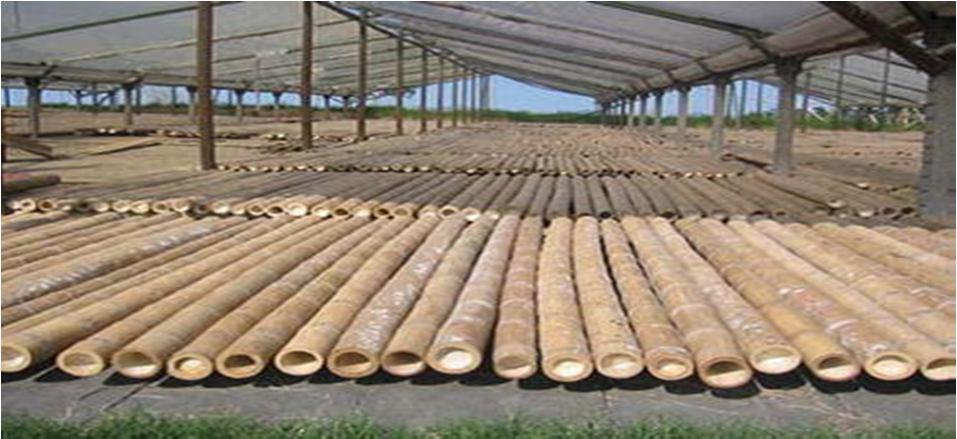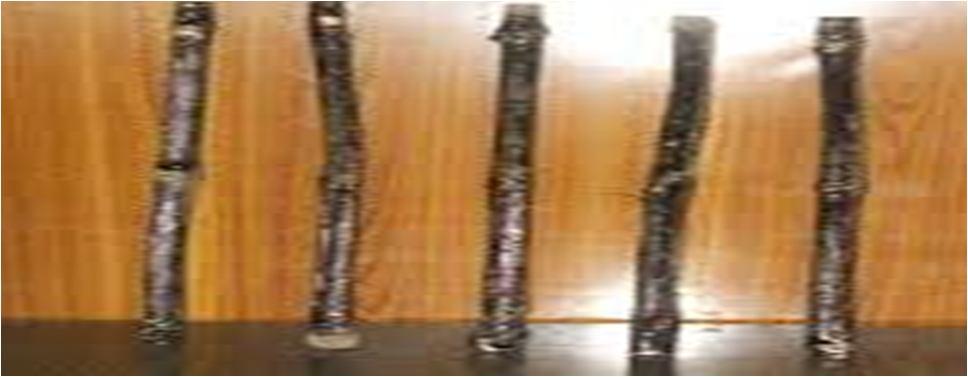
ISSN: 2321 9653; IC


ISSN: 2321 9653; IC
1Associate Professor, Civil engineering Department, Adichunchanagiri institute of technology, Chikmagalur Karnataka, India
2Assistant Professor, Civil engineering Department, Jain University, Kanakapura, Karnataka, India

Abstract: This study presents the evaluation of the feasibility of the use of Bamboo as reinforcement material. Here Bamboo was used as a reinforcing material. Now a day’s concrete is used as the basic materials for construction works. Concrete is good in compression but weak in tensile strength. So, steel is used as reinforcement in the concrete to achieve the tensile strength. Problems encountered with the use of steel are high in cost, corrosion, etc. The main obstacle for the application of Bamboo as a reinforcement is the lack of sufficient information about its interaction with concrete strength and durability.
Keywords: Bamboo, Reinforcement, Flexural test, Slump test.

Bamboo is a giant grass having a place with the group of the Bambusoideae. It is assessed that around 1100 1500 species of bamboo exist and there are additionally around 600 diverse plant types of bamboo on the planet. In this study fully grown Bamboo has been used as reinforcing material. Upkeep expense of a steel structure is high. Because of activity of rust in steel, costly paints are required to re establish time to time. So that resistance against serious conditions increments. Steel has little resistance against flame when contrasted with cement. Just about from 600 700C portion of steel quality decreased. Steel can't be mould in any heading you need. It must be utilized as a part of structures in which segments initially exists. On the off chance that steel loses its pliability property, then odds of weak breaks increment. On the off chance that there are expansive varieties in elasticity than this lead steel to more strain. The expense of development materials including steel is expanding consistently throughout the years and houses are getting to be excessively expensive for basic man. Subsequently keeping in mind, the end goal to give safe house to urban poor of the general public it is important to go either for exchange development materials with routine development procedure or to embrace ordinary materials with substitute development method to decrease the expense of structure. In the present exploration work the principal choice i.e. Alternate construction materials with traditional construction technique had been utilized with the goal to use bamboo sticks of various state of cross section area as a substitute of steel bars in structural member. In these days, structure construction itself means it would of concrete reinforced with steel or RCC structure. Concrete can readily sustain compressive loads but it has low tensile strength. Steel has relatively high tensile strength (792N/mm2) high toleration of tensile strain, steel forms good bond with concrete, irrespective pH, moisture and similar factors. It has thermal compatibility, not causing unacceptable stresses in response to change in temperatures. Also has durability in the concrete environment, irrespective of corrosion or sustained stress.
The objective of

After
2) Coating of Coal Tar:
Figure.3.2:

ISSN: 2321 9653; IC Value: 45.98; SJ Impact Factor: 7.538

10 Issue IX Sep 2022 Available at www.ijraset.com
make
proof and to improve bond
At the time of tension tests, early failure was observed at the gripping end. In some cases, bamboo strip experienced slip at the time of tension test. To solve this gripping problem GI wires (2mm diameter) were wringed spirally at both ends of the specimen.

1) Preparation of Mould: The beam mold of inner dimensions (710mmx150mmx150mm) is used for casting the concrete beam. They are formed from heavy gauge steel plate to maintain dimensional shape and can be easily disassembled for cleaning.
2) Hand Mixing of Concrete: Hand mixing should be done on a smooth, clean and water tight platform of suitable size in the following manner:
a) The required quantity of cement and sand are spread evenly.
b) The sand and cement are then mixed with spade, turning the mixture over and over again.
c) The sand cement mixture is then spread out and measured quantity of coarse aggregate is spread on its top.
d) The whole mass should be mixed at least three times.
e) A hollow is made in the middle of the mixed pile.
f) Three quarters of the total quantity of water required should be added while the materials are turned in towards the center with spades. The remaining water is added and mixed thoroughly.
g) The mixing platform should be washed at the end of the day.
3) Placing of Reinforcement: 3 number of bars are placed in the beam mould at a distance of 40mm and 4 number of stirrups are placed at a distance of 180mm C/C.Reinforcement is placed with a cover of 20mm
Figure.3.3: Placing of Reinforcement.

a) Normal Reinforcement.
b) Partially Replaced Reinforcement. c) Totally Replaced Reinforcement.
4) Casting of Beam: Prepare the test specimen by filling the concrete into the mould in 3 layers of approximately equal thickness. Tamp each layer 35 times using the tamping bar. Tamping should be distributed uniformly. After rodding each layer, use a trowel and Strike off to a flat surface and get a proper finishing. After 24 to 48 hours demolding is done. The specimens will be transported to the water tank for curing. Specimen identity will be noted along with the date and time the specimen was made. Then the beam is kept for curing for 28 days.



7920
8080
6720
7550
7400
3200
3200
3120
2321 9653;

1.38
1.2

1.19
12.75
1.13 11.085
0.5 0.506 5

0.5
0.52
0.88 8.71

1)
2)

this project
have opted advanced bamboo
technique
of traditional steel reinforcement. This is a good idea for low cost economical structure.
is three times cheaper than the steel reinforcement technique. It is clear from results that this bamboo reinforcement technique is absolutely cheaper than steel reinforcement technique especially for single story structure.
It has been observed experimentally that the load taken by bamboo reinforced beam is 39% less than that of steel reinforced beam.
4) It has been observed that the bamboo reinforced beam failed gradually, Bamboo sticks have abilityto work as the reinforcement due to its tensile strength.
5) Bamboo Stick has more flexural strength than plain concrete beam and hence it can be used as tensile reinforcement.
To increase further flexural strength of bamboo stick reinforced beam the waterproofing agent with more bonding should be applied.
Bamboo Stick is cheap and hence it can lead to low cost housing technique in rural areas where the cost of steel is very high.
8) Abetter flexural performance has been observed with increase in number of reinforcements, diameter of the bars and addition of shear links to the bamboo reinforced beams.
[1] KhosrowGhavami, Jindal,VaradaRajuluChembi and Nimityongskul, “Bamboo as a reinforcement in structural concrete elements”, 4 June 2004.
[2] M. M. Rahman, M. H. Rashid, M. A. Hossain, M. T. Hasan and M. K. Hasan, “Performance Evaluation of Bamboo Reinforced Concrete Beam”, August 2011. 1110504 2626 IJET IJENS
[3] Javadian, Alireza, Hebel, Dirk E,Wielopolski, Mateusz,Heisel, FelixSchlesier, KarstenGriebel, Dragan, “Bamboo Reinforcement A Sustainable Alternative to Steel” October (2014) ISBN: 978 84697 1815 5.
[4] FarhanaNaznin and Dr.NayanmoniChetia, “A Study on Bamboo Reinforced Concrete Beams” Held on July 13, 2015 in Hotel Sandesh The Prince, Mysore, India http://warse.org/IJSAIT/static/pdf/Issue/iccet2015sp07.pdf.
[5] Sri murniDewi and Devi Nuralinah, “The Recent Research on Bamboo Reinforced Concrete” MATEC Web of Conferences. January 2017.103:02001
[6] Indian standard code of practice for plain and reinforced concrete for general building construction, IS 456: 1978. Bureau of Indian Standards, New Delhi.

